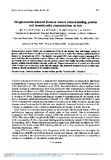| dc.contributor.author | Tuitoek, Prisca J. | |
| dc.contributor.author | Ritter, S.J. | |
| dc.contributor.author | Smith, J.E. | |
| dc.contributor.author | Basu, T.K. | |
| dc.date.accessioned | 2017-08-31T12:43:57Z | |
| dc.date.available | 2017-08-31T12:43:57Z | |
| dc.date.issued | 1996-12 | |
| dc.identifier.citation | Br J Nutr. 1996 Dec;76(6):891-7. | en_US |
| dc.identifier.uri | https://www.cambridge.org/core/journals/british-journal-of-nutrition/article/streptozotocininduced-diabetes-lowers-retinolbinding-protein-and-transthyretin-concentrations-in-rats/5A2FD31FE44DB49C1CB28DFBCC724545 | |
| dc.identifier.uri | http://hdl.handle.net/123456789/2766 | |
| dc.identifier.uri | https://doi.org/10.1079/BJN19960095 | |
| dc.description | DOI: https://doi.org/10.1079/BJN19960095 | en_US |
| dc.description.abstract | Retinol-binding protein (RBP) and transthyretin (TTR) in the plasma, liver and kidney, retinol in plasma, and total vitamin A in the liver were measured in rats 6 weeks after diabetes mellitus had been induced by streptozotocin (STZ). The diabetic rats gained 83% less weight despite consuming 45% more feed than the non-diabetic controls. Plasma and kidney concentrations of RBP and TTR were significantly lower in diabetic than in the non-diabetic control rats. Unlike the retinol carrier proteins, plasma albumin concentrations remained unaffected. Plasma concentrations of retino1 were decreased while its hepatic levels increased in the diabeticanimals. The depressed circulatory levels of retinol may reflect an altered metabolism of its transport proteins | en_US |
| dc.language.iso | en | en_US |
| dc.publisher | The British Journal of Nutrition | en_US |
| dc.title | Streptozotocin-induced diabetes lowers retinol-binding protein and transthyretin concentrations in rats. | en_US |
| dc.type | Article | en_US |

